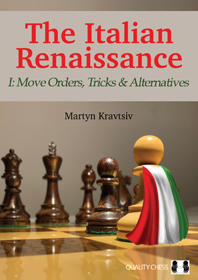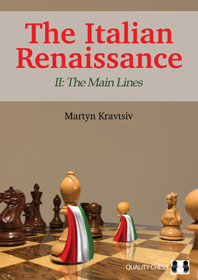Both volumes of The Italian Renaissance by Martyn Kravtsiv – Move Orders, Tricks & Alternatives and The Main Lines –will be published on August 26.

Volume I covers the Bishop’s Opening (1.e4 e5 2.Bc4) and the Petroff Defence (1.e4 e5 2.Nf3 Nf6). An excerpt is here.

Volume II covers the Italian Game (1.e4 e5 2.Nf3 Nc6 3.Bc4). An excerpt is here.
Taken together, these books show how White can challenge 1.e4 e5 with lots of creative new Italian ideas. I edited these books, so I know how much amazing chess they contain – plenty of Ukrainian GM human cleverness, not just deep computer analysis.
I hope you like them when you see them, with the two excerpts now just a brief taster.
These Italian books appear likely to be “must haves” for anyone who plays 1.e4 e5 from either side. They also appear to provide additional evidence that Black’s best (or only?) move after 2.Nf3 is 2…d5.
> They also appear to provide additional evidence that Black’s best (or only?) move after 2.Nf3 is 2…d5.
Or even the accelerated Elephant with 1.e4 d5 !?
as for “must for both colors”: In case Black plays the Two Knights defense, this book will be of limited use, as it only seems to cover 1.e4 e5 2.Nf3 Nc6 3.Bc4 Nf6 4.d3 and a black system with h6,d6 and g5 (or g6). Or maybe it’s the only independent variation?
It will be interesting to see how Kravtsiv deals with the recently published ‘bullitproof’ Petroff repertoire… Many variations in that book with the modern mainline 5.Nc3 end in perpetual checks.
@Cowe
There is plenty in this book if your interest is the Two Knights Defence as Black. After 3…Nf6 the author recommends 4.d3 then, as you mention, there are independent options of 4…h6 with a later …g6 or …g5 (Chapter 13).
More mainstream after 3…Nf6 4.d3 is Black playing a later …Be7, which is over 20 pages of Chapter 12.
While if after 3…Nf6 4.d3 Black plays a …Bc5 line (which I think he should) then it is transposing to main lines, covered earlier.
@John Shaw
You still didn’t mention whether Krvatsiv manages to beat the bulletproof Petroff book…it would be really interesting to see this.
@A Super Talent
We compared the lines where they meet and found they were both essentially correct. So whereas Swapnil may have ended a certain line with an ‘equals’ evaluation, Martyn was of the opinion that White could still try to press by trying this or that idea. This seems like a pretty normal state of affairs when both sides play well, so we are satisfied with the way both books hold up to the comparison.
Nice effort by the author to have its readers covered against 2 Knights defense, mosly by d3 & Bc5 systems and by adding extra chapters for independant variations.
Not a question for this book, but we don’t see much classical 2K in top chess (Ng5 and so on), is it because White plays d3 anyway (like Morra and Alapin) or does Black vastly prefers 3…Bc5 ?
For the Italian proper with 3.Bc4 Bc5 I agree that the book would benefit both sides, if nothing else because White can try to play with colours reversed and extra tempo.
Hello,
I saw the Abridget Opening Tree and it seems that the books are not about the “Modern” treatment of the Italian Opening: I mean with a really delayed long castleing option, as – for example – in the Tiviakov games. Is it correct?
Thank you in advance for your answers.
@saintex
Seems correct that such lines with delayed castling, and reserving the 0-0-0 option, are not covered.
However, I’d beg to differ: these ideas are never used in top level play nowadays, and they have been conclusively proven harmless for Black. Nothing ‘modern’ about them anymore!
@middlewave
Thank you for your answer!
@middlewave
Thinking to your answer:
> these ideas are never used in top level play nowadays, and they have been conclusively proven harmless for Black. Nothing ‘modern’ about them anymore!
This is interesting: is there any arguments in the book that demolish these lines?
@saintex
No idea – the book is not even out yet!
I was referring to the general perception about these lines that has prevailed in the last several years, plus the relevant material in various recent works on this opening. The main takeaway: as soon as White goes Nf1, delaying castling, Black replies immediately with …d5 and stands at least equal.
In general, I think such an approach from White would only work if Black sits tight and mindlessly develops, allowing White to nicely set up his kingside play with Qe2, Nf1-g3, perhaps with g2-g4 thrown in. This doesn’t happen anymore. Black players know well to avoid this scenario by now: play …d5, usually exchange on e4 opening files, maybe go for a quick …Nh5-f4 after that, or quickly play in the center with pieces. The current state of theory reflects this consensus; Black is more likely to seize the initiative than White.
> This doesn’t happen anymore. Black players know well to avoid this scenario by now: play …d5, usually exchange on e4 opening files, maybe go for a quick …Nh5-f4 after that, or quickly play in the center with pieces.
Thank you for your explanation, really usefull for me!
Welcome!
Actually, even Mihail Marin was covering this line very efficiently for Black in his old QC book, proposing this general plan of action. I believe not much has happened since.
Chess Direct in UK always reliable and arrived already. Sitting down with my builder’s tea watching the rain outside…perfect time to peruse ?
Under the Bishop’s Opening, I’ve been looking forward to coverage of the symmetrical approach by Black, because it’s completely missing from many books on the 2.Bc4 move order (e.g., Delchev’s book on Bc4 in the Open Games doesn’t cover 2…Bc5 or 2…Nf6 3.d3 Bc5 at all). Kravtsiv indeed covers it thoroughly–and now I’m surprised that the choice is an early Nc3! If Black plays …c6 (e.g., 1.e4 e5 2.Bc4 Nf6 3.d3 Bc5 4.Nc3 c6), Stockfish considers the position slightly better for Black! (I’m sure that’s not actually true, but still looking forward to seeing the details when I have the book in my hands.)
I just received my copies of the two Italian Renaissance volumes and also Think Like A Machine. These books seem impressive and I look forward to reading them BUT (and it’s a big but) Kravtsiv, unless I’ve gone blind, fails to cover in volume 2 a major option nowadays, viz. 1 e4 e5 2 Nf3 Nc6 3 Bc4 Bc5 4 c3 Nf6 5 d3 d6 6 0-0 and now 6…h6 as played in hundreds of elite games in recent years. Black first rules out Bg5 and preserves his options with the a-pawn.
I have two correspondence games on the go with this right now; in one my opponent played 7 b4 and in the other 7 a4 (met by 7…a5). Maybe if White had played 7 Re1 or 7 Nbd2 transposition to lines in the book would arise but the failure to even mention 6…h6 is a surprise and a disappointment. Maybe one of your downloadable supplements will be needed?
I suspect the problem is with the author writing in Russian and then having it translated, so it cannot be as up to date as your books where the author writes in English. But high-level games with 6…h6 started being played in 2018, if not earlier?
@Tim Harding
Looking at it purely as a repertoire for White, I’d be satisfied that there’s coverage of 7…h6 (a move later, after Black has castled) in chapter 11, because after 6…h6 I’d play 7.Re1 O-O 8.Nbd2 (transposing). But if I were hoping for some coverage of 6…h6 from Black’s point of view, I can imagine being disappointed.
@Benjamin Fitch
I also noticed the emission of an early …h6 move order. But indeed it seems it will transpose. However, I agree it would have been good to point this out. I noticed anyway that the author doesn’t say a lot (if anything) about move orders, but goes to the main tabiyas straight away. I’m Always confused by all the subtleties of move orders in the Quiet Italian – it’s not my cup of tea. A final note: an early …h6 is recommended by Hammer on Chess24. He doesn’t go into great detail however. He more or less stops where Kravtsiv begins his analysis 🙂 .
Yes, I can be happy that neither of my opponents can use Kravtsiv’s book against me since they have diverged from his recommendations, but if I was going to play the Italian with White then I would have welcomed an opinion about 6…h6. It does look as if 7 Re1 0-0 8 Nbd2 is covered in Chapter 11 and it’s probably hard for Black to avoid transposing to that.
Doing a search for players over 2600 who have employed the early …h6, I see first Ivan Sokolov in 2006 and 2008. Then it starts trending in 2016 when among others it has been played by Howell, Adams, Kasimdzhanov, Carlsen, Topalov, Kramnik and Anand. Last year some GMs were playing 5…h6 as well, transposing after 6…d6. This year, when rapid and blitz have predominated, 6…h6 has often been played by Nakamura but also several other top GMs.
For the record, Delchev’s recommendation for White after 6…h6 is indeed 7.Re1, but he briefly discusses 7.b4 (without recommending it). And after 7.Re1, he technically covers both 7…O-O and 7…a5, but the latter is not independent (after 8…O-O). It just happens to be covered in a different section. Move orders are fun! 🙂